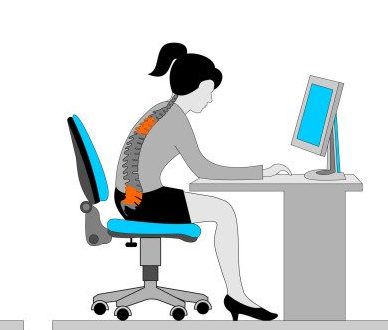How Kettlebell Workouts Can Help Improve your Posture
Today’s guest post comes from the fine folks at Kettlebell Kings, so if you’re interested in getting some new kettlebells or some solid kettlebell workouts for your home gym or studio, check them out!
In today’s society, it is easy spend a lot of time in a flexed posture, whether it’s from sitting at a desk all day or a sedentary lifestyle on the weekends. The good news is that slumped shoulders and a curved or hunched back can be improved through regular exercise with a kettlebell. Kettlebell training can help strengthen the muscles that are causing you to slump over and reinforce being strong in those new positions. There are several muscle groups in the body that effect moving from flexed into extended postures, and by working these areas through kettlebell movements and you can improve your posture in a short amount of time each week.

Fix #1 – Strengthening Weak Glutes
Your glutes consist of three different muscles; the gluteus maximus, gluteus medius and gluteus minimus. Apart from being important for padding, these muscles also stabilize your pelvis, and if they are weak, it leads to other muscles working to hold your hips and spine up while sitting or standing. When sitting, weak glutes cause an over activity in the hamstrings that creates a backwards tilt of the pelvis. When you have a slight posterior pelvic tilt, the back and shoulders follow by slumping forward. Over time, this will leave you hunched over and might make your back muscles stiff and cranky.
There are many kettlebell exercises that strengthen the glutes, however, one of the most effective exercises is the kettlebell swing. Incorporating even 1-5 minute increments of kettlebell swings into your daily routine can reverse the effects of poor posture by strengthening the muscles. To perform this exercise, stand with your feet slightly wider than shoulder width apart with an overhand grip position on the kettlebell with both hands. Bending at the hips with back straight, let the kettlebell fall slightly behind your legs, then squeezing your gluteal muscles and using your hips, swing the kettlebell up and away from your body. As the kettlebell descends, keep tension in your glutes to control the downward swing. End the movement by bending at your hips as the kettlebell swings back to its original position behind your legs.
Fix #2 – Straightening a Rounded Back
When your glutes are weak and you exist in a posterior pelvic tilt while sitting, the muscle groups in your lower back wind up creating a curvature or rounding. To counteract this rounding, it’s important to focus on strengthening the muscles that run along your spine. Without strength training of these muscle groups, it can increase the stress through the region and make those areas work harder without recovery, a recipe for a cranky low and mid back.
To help reverse this pelvic tilt and strengthen lower and upper back muscles, the kettlebell deadlift can be executed a few times a week. To begin, start with your feet shoulder width apart with an overhand grip on the kettlebell using both hands. Begin the movement by pulling your glutes backward and keeping your back straight as you bend forward at the hips. Your mid and lower back with have to stabilize you throughout the movement, as you push your hips toward the back of the room. Come up to an upright position the same way, keeping slight tension in your back, glutes and hamstrings and finishing by standing tall with shoulders back.
Fix #3 – Pulling Your Shoulders Back
Rolled over and hunched shoulders are more likely a cause of muscle weakness than a lack of flexibility, however both should be addressed. When the upper back is flexed forward, the shoulders also move into a forward position. To address this issue and avoid upper back issues, it’s important to strengthen the muscles of your shoulders so that they can move back into a more energetically efficient position when sitting and standing.
One of the best kettlebell exercises for the shoulders is the kettlebell military press. This can be done using two kettlebells and both hands or just utilizing one kettlebell. For the beginner, it is suggested that you stick with a solo kettlebell, warming up with 8-10 reps of 3 sets to engage the shoulder muscles. Begin by cleaning a kettlebell to your shoulder with your palm and wrist facing forward. Press the kettlebell up and out until it is locked out above your head. With control, lower the kettlebell back to your shoulder and repeat. Be sure to engage the muscles of your glutes, core and latissimus dorsi (used to help pull the shoulder back and down to work against that forward roll).
Kettlebell exercises are effective because the majority of these routines train your entire body. When you are executing the kettlebell swing specifically, you are not only engaging the glutes but the abs, core, back, shoulders and hamstrings. All of these muscles work together, become stronger and can help increase their relative flexibility over time. For those of us with office jobs, who are forced to sit a desk for long periods of time, these workouts can greatly reverse the effects of those forward flexed postures.
If you are looking for a kettlebell to use during your workouts, the experts at Kettlebell Kings can help. We are the foremost experts in the industry and are more than happy to assist you in finding the kettlebell weight and size that works best for your end goals. Call us at 855-7KETTLE today or visit our blog at www.blog.kettlebellkings.com to find out more about our products and free kettlebell workouts you can do at home.